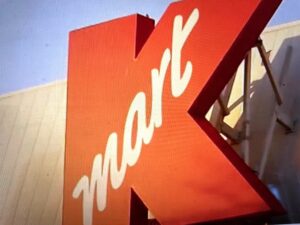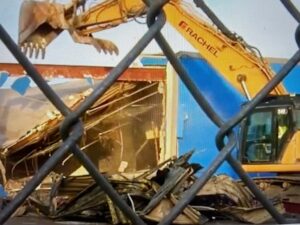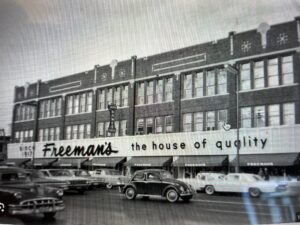 BY KAY SCHROVEN
BY KAY SCHROVEN
Recently, I ran into a friend whom I’d not seen in a while. She is a suburbanite. During the conversation she mentioned that she and her husband had recently driven down East Lake Street for the first time in a while. “What a shit show!” she said, adding, “We thought of you.” I probably shouldn’t have been, but I was stunned. I didn’t know quite how to respond. It seemed a bit rude and presumptive. Would it not have been better to ask, “So, how are things in your neighborhood?” Clearly her view is different than mine.
Later, I wished I had told her about the Fourth Annual Southside Summit on Nov. 10. About the many folks who attended and brought

The demolition of Kmart
their hearts and souls with them in an effort to rebuild, grow and improve the Southside neighborhoods of Minneapolis; people who care, are invested, are innovative, offering their time and skills working together toward the greater good. People who call the city home, and either can’t or don’t want to flee to the suburbs.
This encounter inspired me to take yet another trip down East Lake Street. As I prepared to do so I remembered the first time I encountered Lake Street in the late 1980s. I recall how amazed I was, how long and interesting it was! I fixated on the antique stores. I discovered Antiques Minnesota, which remains a fond memory, among other sites, some still with us, others not.
Fast forward: yes, this historic street with many stories to tell has been damaged. We need not rehash the 2020 pandemic, riots, etc. East Lake Street is approximately 3.5 miles long. Between Nicollet

The fires that destroyed Minnehaha Liquors
Avenue, where the Kmart site is being demolished, and the Mississippi River I counted 20 lots that were empty or seemingly abandoned properties in need of attention. Is this the “shit show” my suburban friend saw? Was it the many murals and graffiti that offended her sensibilities? The people on the streets? The diversity? The apparent homelessness? Labeling the unsheltered a “shit show” makes it easier to ignore, does it not? Does racism play a role here? Is it the lack of luster? Is it because there aren’t enough Starbucks? L.A. Fitness options? GAP stores? Whole Foods? Crave and Culver’s restaurants? Unlike many suburbs that have no sidewalks (because car ownership is assumed), the city has sidewalks, and life goes on there.
Yet, the spirit of Lake Street survives, and rebirth is in progress. We’ve seen the big box stores like Target rebuild first. With the help of grants, loans and innovation, some of the small businesses have followed. And we now have two major renovations in the works to look forward to.
Goodbye Kmart, hello neighbors
Those of you old enough to remember the Mary Tyler Moore show (or those who’ve rediscovered this classic) may recall that Mary and Rhoda were always meeting at Lake and Nicollet for lunch. When I moved to Minneapolis and realized where this intersection was I wondered if Mary and Rhoda were having lunch at the Kmart? I guess there was a lunch counter there at one time. I digress.

Members of the community help with the cleanup after the 2020 George Floyd riots at Chicago and Lake Street.
Imagine the Kmart gone, and the 10-acre property redesigned with respect for pedestrians and the local businesses. Imagine green spaces, public transportation, bike trails, affordable housing, commercial space, and food and retail options. Since the construction of the Kmart in 1978, Nicollet Avenue has been split into two parts, separating the neighborhoods and blocking a major artery. The renovation will reunite the neighborhoods. This is the essential goal of the renovation project. Mayor Frey said, “That was one of the worst urban planning decisions ever made. This renovation will transform the community.”
The city bought the property for $9.1 million with plans to demolish it. A recent fire on Oct. 10 moved the demolition date forward. In the meantime community members had an opportunity to give input until Nov. 15. Regardless of location, the end of Kmart’s run is not unique to Minneapolis. Kmart stores are closing all over the country, having lost out to innovative technology, Walmart, Target and Amazon. A few stores remain in Florida, New Jersey, New York, and the Virgin Islands. In Minneapolis the wrecking ball is scheduled to hit soon. Maybe the demolition has already begun. Reconstruction will follow. Surely between 2025 and 2027 the community can expect a safer, greener neighborhood for fulfilling day-to-day needs.
See the new Coliseum
At the intersection of 27th and East Lake Street in the Longfellow neighborhood sits the Coliseum Building, the former Podany Building that sold office furniture. Before that it was Freeman’s Department Store for 50 years, from 1917 to 1975

The Coliseum building when it was Freeman’s and how it looks now
(the letters now fading on the side of the building). Freeman’s was known for offering credit to minorities at a time when it was rare. The popular family-owned business flourished in the 1920s, holding its own through the Great Depression. Historically the building was surrounded by thriving businesses including Minneapolis-Moline (a farm implement manufacturer), Smith Foundry and Bituminous Roadways. It would take a full chapter to even begin to summarize the colorful history of this consequential street and building which sits on native land once the home of the Dakota and Ojibwe people. Binesikwe Means of MIGIZI says, “I hope Lake Street and its businesses continue to reflect the diverse communities that live in Minneapolis.”
The new Coliseum will do just that. Quick update – the nonprofit Redesign Inc., which has been around since the 1970s, bought the 85,000-square-foot building for $2 million in 2021. Its mission is to  return the building to the neighborhood/community by offering affordable rents to small businesses owned by BIPOC individuals and immigrants who have played a major role in building commerce on Lake Street over the years.
return the building to the neighborhood/community by offering affordable rents to small businesses owned by BIPOC individuals and immigrants who have played a major role in building commerce on Lake Street over the years.
Raising $28 million for the restoration has not been easy, requiring nontraditional approaches, nontraditional development, and community involvement. Contributors include the state, county, local and private businesses, as well as federal help in the form of tax breaks. Because the building is on the National Register of Historic Places, the investors will receive particular tax breaks. They will also need to adhere to the standards of renovating a historic property. Taylor Smrikarova is director of the Redesign project and Alicia Belton is the lead architect. Belton says, “The building has good bones, high ceilings and lots of windows. We will be able to preserve the terrazzo floors and marble staircase.” Because it is a historically preserved building there can be no exposed ductwork or pipes, and ceilings cannot be lowered.
Along with Redesign there are three Black entrepreneurs/investors involved in the project: Chris Montana of Du Nord Craft Spirits; Janice Downing, a management consultant with Common Sense Consulting; and Alicia Belton, the lead architect and founder of Urban Design Perspectives. The three owners are investing $3.5 million from the Commercial Property Development Fund, a city-developed fund that helps capital-light entrepreneurs acquire buildings in challenged neighborhoods.
More than a building
The new investors approached the project as more than just a property renovation. They shot down the idea of new construction because they believe the building plays an important historic role and deserves a new lease on life, as does the neighborhood. Their mission is to create a community space and event center involving historically marginalized groups of people who will now be able to develop asset ownership. The building represents resilience, having survived two separate fires in 2020 related to the civil unrest and a host of historic challenges.
Plans include space for community art and healing, an event center, a hair salon and barber shop, a roof deck with storage for bikes and a shower, a Mothers’ Room, a first-floor bar and lounge, and several restaurants. Public transportation and EV stations will be nearby. In addition there will be move-in-ready rental space for businesses, meeting and conference rooms. Over time, once the tax credits are paid off (in approximately seven years) Redesign’s plan is to bow out and the three investors will take ownership of the Coliseum.
East Lake Street today
Meanwhile, with the Kmart and Coliseum projects underway, you can still enjoy and support East Lake Street. You can pick up some smokes or a new phone, have a beer and some excellent food. You can donate plasma, get your car washed and tuned up, maybe some new tires. You can do your banking and get your taxes done. You can shop for groceries, clothing and furniture, go to church, get your hair and nails done, and enjoy a fresh cup of coffee and a pastry. Maybe you need a chiropractic adjustment or a dental visit. You can also get your laundry and dry cleaning done. Got kids? There are child care centers available. You can get your prescriptions filled and your rugs cleaned, pick up some fresh flowers or a unique gift, explore the newly legal THC products and a variety of live and recorded music. Got a home improvement project? Visit the hardware stores of Lake Street. Need a real estate agent? A vet for Fido? Another tattoo? An ice cream treat? It’s all there.
I do not see a shit show when I am on East Lake Street. I see and am aware of the problems – homelessness, crime, addiction, poverty, and the needs of Lake Street. I also see hard-working people, shopkeepers, entrepreneurs, employees and shoppers. I see families and friends dining out together, and folks throwing darts or shooting pool. I see people working together, often across cultures. I see colorful murals, some painted over what was damaged after the 2020 upheaval in an effort to transform destruction into art. I hear music from the U.S., Africa, Mexico, Asia, and elsewhere. I see people shopping, going to church, or taking their kids out for a treat.
I believe that what we see is in line with our values and our ability to imagine. One of these days I’ll have a chat with my suburban friend. Maybe we can both learn something.






















